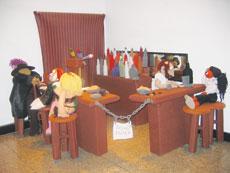Restructuring the Substructure

April 11, 2006
The first impression one gets of the UMass Boston campus really depends on whether you need to park or not. Those who take the shuttle from the T stop are dropped off at the glass-and-limestone Campus Center, sparkling in the sunlight. Those who drive are forced into the decrepid upper and lower level parking garages where it is murky and dark except for an eerie yellow-orange glow.
Aside from the off chance of being chased by threatening individuals, the most disturbing thing about walking through the garages are the danger of being flattened by large boulders of falling concrete. The nets that hang overhead (presumably to catch the plummeting rock) provide little reassurance.
There are multiple reasons behind the deterioration of the parking structure. An especially troubling cause of our current predicament is due to serious flaws in the initial construction of the Harbor Campus.
The deficiencies in construction are far reaching. The biggest problem with the early construction was the use of very low-grade concrete. The poor quality concrete is far more lightweight than that of higher quality. This lack of density allows for salts and moisture to seep through the concrete and cause corrosion to occur more quickly.
In addition to the low-grade concrete, the building was not covered with a sufficient amount cut “of concrete”. In some areas of the parking facility there is only half an inch of concrete cover over the reinforcement.
Corrosion of the concrete has also been exacerbated by poor drainage. The parking structure was constructed with a slope for drainage at a one-foot decrease in height for every 16 lateral feet. This is a third of what is considered a good floor slope for drainage. This lack of slope has resulted in “puddling” and increased moisture and salts in the garage.
The campus was originally built in the early 70’s. Construction was supervised by the company McKee-Berger-Mansueto. The acquisition of the contract to build UMass Boston by McKee-Berger-Mansueto is the central part to one of the largest and most publicized scandals in recent Massachusetts history. The so-called MBM scandal resulted in jail time for two state Senators and a string of sweeping reforms in how state public works projects are done.
Evidence of corruption and scandal began to surface soon after the contract was given to MBM. The Ward Commission, the group that was charged with investigating the scandal, determined that MBM received the contract by making two large payoffs to state Senators and promising money to the governor.
The two Senators involved, Joseph DiCarlo and Ronald MacKenzie both were convicted with charges of extortion charges. They each spent a year in prison. The two had received more than 40,000 dollars from MBM. MBM received well over five million dollars from the state to oversee the construction. In 2005 that would cost about $80,000.
The scandal at UMB was not an isolated event. The Ward Commission determined that “Corruption is a way of life in the Commonwealth of Massachusetts” and that “For a decade at least, across Republican and Democratic administrations alike, the way to get architectural contracts was to buy them.”
The result of this corruption was “shoddy and debased standards” in construction. Here at UMass Boston, we are now paying the price for corruption that occurred thirty years ago.
In addition to the problems here at UMB, there were problems with design and construction at other major public projects. There were the leaking roofs and defective walls at Cape Cod Community College, the library at Salem State College that couldn’t support the weight of the books it was built to house, the former Boston State College auditorium where a third of the seats had no view of the stage, and the Worcester County Jail with the malfunctioning locking system.
Out of all of these, our campus has certainly been the worst. Since it first opened, there have been severe problems. Ventilation issues and leaks continue to plague the campus. Years ago the bricks from the library façade fell off and had to be replaced.
The heating system has also come with its own set of disasters. The original electrical heating system was introduced because of how incredibly cheap it was. Although it was inexpensive to install, the price to actually heat the building was enormous. It was also incredibly inefficient in terms of energy use. Eventually the entire electrical system had to be replaced.
The amount of money that these constructional deficiencies are costing state tax payers is incredible. The Ward Commission concluded that of the $17.1 billion the state’s public sector had spent on construction projects since 1968, $7.73 billion had gone for projects.
The renovation of the garage alone could cost about $50 million. The university also needs money for deferred maintenance, which could cost as much as $100 million. The longer the wait, the more daunting this price tag becomes. If repairs are delayed too long, complete structural failure is certainly imminent.

























































